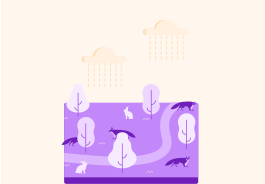YOU ARE LEARNING:
Environmental Change

Environmental Change
Different factors can influence an environment. Species will react to a changing environment in different ways, but this could affect their distribution or abundance in a certain area.
An ecosystem is the combination of the different species in a given area and the different physical factors that affect the abundance and distribution of these populations in that area.
We use the term biotic factors when we refer to populations of different species in an ecosystem. What term do we use when we refer to non-living factors that affect an ecosystem?

Three of the most significant abiotic factors that affect the distribution of species and the abundance of their populations are, temperature, access to water and atmospheric composition.
Abiotic factors can change. Which of these might be reasons for abiotic factors changing?

You can select multiple answers
Temperature
In temperate climates, for example Northern Europe, temperature changes as seasons change.
This affects the growth of plants which affects the distribution of many animal species.
Other populations might be affected because the abundance of they prey changes with the seasons. Which of these population's distribution is affected in this way?

The location of an ecosystem of course also matters for temperature.
Areas near the equator are on average warmer than those closer to the poles.
In Central Europe, the red fox is a common species in many ecosystems, but in northern regions, like Lapland in North Finland, the red fox is replaced by arctic fox. What adaptation helps the arctic fox survive where the red fox can't?

Average global temperatures have been rising over the last 100 years. What human activity is most responsible for this long term change in temperatures?

Access to water
As the seasons change, rain fall and temperature affect access to fresh water.
Once the ground is frozen plants can't take up water anymore. This means that we get deciduous trees growing where evergreens can't grow.
Why can a deciduous tree survive in an area where the ground is frozen in winter?

Desert environments are extreme examples of how water is limited by geographical location. Only organisms that are adapted to these low water conditions can survive. What type of plants can live in desert conditions?

Cacti have several adaptations to the low water conditions in deserts. They have very small leaves to reduce the area for water loss, and they use a different type of photosynthesis (C4) that uses less water than normal photosynthesis.
Atmospheric gases
The major gases in the atmosphere do not change with the seasons or with geographical location.
The air contains 79% nitrogen and 21% oxygen. It is the changes in some of the minor components that can affect the distribution of some species.
Lichens are small plants that grow on walls and trees. They are often found in the countryside, but they are very uncommon in the middle of large cities. What factor could be the cause of this distribution?

Changes in the levels of which gas in the atmosphere is causing the sea ice in the Arctic to melt?

The change in the amount of seasonal sea-ice affects the distribution of polar bears, that hunt seals on the ice.
What is the cause of this change?

What might this decline in sea-ice do to the population of polar bears in the Arctic? Pick all the options you think are correct.

You can select multiple answers
